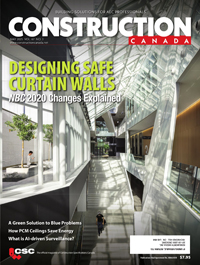Waterproofing considerations for green roofs
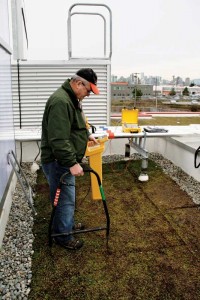
Photo courtesy Detec Systems
Attachment methods
The roof membrane can be mechanically attached or fully adhered in the roofing system, but the latter is often preferred on green roofs. The former method involves first securing the roof membrane to the deck using fasteners and plates; a second layer then covers the row of fasteners with a seam. The fasteners/plates can abrade and may lead to puncture of the membrane from foot traffic, especially for thinner membranes.
Further, when a breach occurs in the membrane, water can travel a considerable distance from the source, making it difficult to locate the leak. Due to these drawbacks, a fully adhered system—though more labour-intensive and thus more expensive—is often preferred over the mechanically attached system in green roof applications.
Roofing details
General good roof design practices apply when it comes to vegetated assemblies. A robust and durable membrane should be installed over a solid deck with at least two per cent slope to drains. Co-ordination of trades (i.e. roofing and landscaping) is particularly important. Most roofing installers would be more careful when they are waterproofing a green roof as to avoid difficult leak location and repair in the future.
A roofing installer would typically waterproof up a wall adjoining a roof to 200 mm (8 in.) above the roof surface, followed with metal counter-flashing to ensure moisture from melting snow does not seep behind the façade. For green roof applications, this distance should be measured from the green roof surface (i.e. growing medium surface) instead. Therefore, if the green roof consists of 150-mm (6-in.) deep growing medium, the waterproofing should go to a minimum of 350 mm (14 in.) up the wall. The parapet wall should be constructed at least 100 mm (4 in.) above the green roof surface, and the waterproofing membrane should wrap around the top of the parapet, and then be covered with metal flashing.
Drainage is important for roofs, but more so when vegetation is involved. Ponding water on a regular roof can easily dry out on sunny days, but it can remain wet under a green roof. Prolonged ponding water can shorten the membrane’s service life so positive drainage is critical. Roof drains should be installed slightly sunken to avoid any drainage barrier. They should be equipped with slotted covers to block gravels and catch leaves. If possible, the roof should be designed into separate sections of waterproofing for each roof drain according to the drainage geometry. Compartmentalizing the drainage areas facilitates leak location in the future.
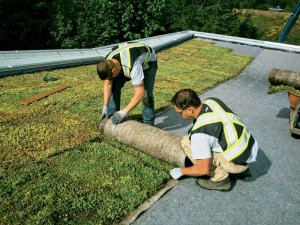
Photos courtesy Xero Flor International
The plants should be kept at least 300 mm (12 in.) away from roof drains to prevent clogging by overgrown plants and dead biomass. This non-vegetated border should be filled with washed round river stones on top of a drainage mat. On roofs with low structural load-bearing capacity, emergency overflows, like scupper drains, should be planned to divert excess water off the roof in case the main drains become clogged.
Areas difficult to waterproof—such as horizontal-vertical interfaces around the parapets, equipment, or penetrations (e.g. for drains and pipes)—tend to be more susceptible to leaks. To facilitate access to these areas for membrane repair in the future, it is recommended designers keep the green roof away from these elements by at least 300 mm with a non-vegetated border filled either with washed, round river stones or concrete pavers.
Concrete pavers are commonly used to create access paths on green roofs. They should never sit directly on the roof membrane as abrasion created by foot traffic can potentially wear down or puncture the membrane and lead to leaks. The pavers should be placed on properly designed pedestals with adjustable height and spacers so the pathway will be level and have fixed spacing between the pavers for moisture diffusion.
Leak detection
There are many non-destructive leak detection techniques for roofing systems available on the market. Although flood test is often conducted, the Canadian Roofing Contractors Association (CRCA) and its U.S. counterpart, the National Roofing Contractors Association (NRCA), do not recommend it as part of a routine quality control or quality assurance (QA) program. (See CRCA’s 2009 advisory bulletin, “Flood Testing.”) Further, it is inappropriate for identifying potential leak sources.
Electric Gradient Leak Locate (EGLL), also known as Electric Field Vector Mapping (EFVM), is an effective non-destructive technique to detect and locate membrane leaks on both roofing systems and green roofs. (For more information, visit www.detecsystems.com). EGLL uses an electric field tracing receiver to detect and trace a signal generator fault current flowing from an excitation conductor to the roof deck through a breach in the membrane.
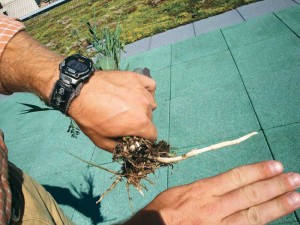
EGLL works on non-conductive membranes such as mod-bits, PVC, and TPO. However, it does not work on EPDM, which is often loaded with carbon black powder that makes it conductive. A designer should take this limitation into account when selecting a roof membrane under a green roof project where leak detection is critical (e.g. computer centre).
The Leak Locate Grid System (LLGS) is a leak-monitoring technique whereby a grid of conductors is placed atop a protected roof membrane to detect leaks within an area defined by the grid spacing. Once a leak has been localized in a grid area, the EGLL system is employed to pinpoint the defect within a grid area. It also works on roofing membranes under a green roof.
Leak detection testing is recommended before and after the green roof installation as quality control. Leak detection or monitoring systems are especially important for intensive green roof systems where finding leaks is very difficult and removing/replacing deep soil and large plant materials can be expensive.
Fire resistance
The fire resistance of roofing systems are rated as Class A, B, or C by ASTM E 108, Standard Test Methods for Fire Tests of Roof Coverings, with A being the most fire-resistant. Based on recent research, ANSI/SPRI VF-1, External Fire Design Standard for Vegetative Roofs, classifies two generic vegetated roof systems as fire-resistive: succulent and grass-based systems in growing media containing at least 80 per cent inorganic materials.
These can be installed on non-Class-A-rated roofs, but the non-vegetated portions should have Class A fire rating. To prevent fire spread into the building, a green roof should also be set back at least 1.8 m (6 ft) away from all abutting vertical surfaces that do not have a Class A fire rating.
For very large green roofs, the ANSI/SPRI standard recommends compartmentalizing the roof into smaller sections no more than 1450 m2 (14,625 sf), with each one having no dimensions greater than 39 m (125 ft), using fire breaks to prevent wild spread of fire across the roof. The fire breaks should consist of a Class A-rated roofing system for a minimum 1.8 m (6 ft) wide continuous border.
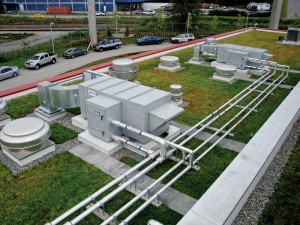
Warranty
Often, a green roof involves two separate warranties—the roofing contractor guarantees the roof membrane system only (i.e. below the green roof system) while the landscape contractor warrantees the green roof system only (i.e. above the roof membrane system). When a leak occurs, there might be dispute on whose fault it is between the roofing and landscape contractors. Often, the roofing contractor would repair the membrane under the warranty, but the owner is responsible for removing the plants and replacing them afterward. This can cause significant stress and substantial cost for the owners. The same situation could happen between the roofing and green roof manufacturers.
To streamline warranty issue for owners, some roofing manufacturers choose to make or carry their own green roof systems. Other roofing manufacturers offer joint warranty with green roof system manufacturers. These arrangements take out one level of headache should a problem occur. Some roofing contractors opt to also install green roofs, especially extensive systems with pre-cultivated vegetation mats and trays, where no real landscape skills and tools are necessary. Other roofing contractors may choose to subcontract the landscape portion of the work to a landscaper, especially on intensive green roof projects involving deep soil and a large amount of planting.
A designer could specify the green roof under the roofing scope so the roofing contractor will carry both the roofing and the green roof warranties, and take care of removing and replacing the plant materials when a repair is needed. This avoids potential dispute on fault and responsibility in the future.
A successful green roof project requires good co-ordination between the roofing contractor and landscape installer. In Europe, it is common for the roofer to finish the roof with a protective layer on top to clearly delineate where the roofing work stops and the green roofing starts (i.e. along with the scope of the landscape installer). This helps minimize disputes should problems happen. For additional peace of mind, it is recommended the leak detection test be performed before and after the green roof installation. This is beneficial to everyone involved—the installers could repair the breach in the membrane before leaks occur in the future and the owner can be assured the roofing system is leak-free.
Conclusion
A successful green roof starts with a robust and durable roofing system. It can be installed on both conventional and protected membrane roofing assemblies, with proper design details. Thicker roof membranes are preferred for long-term durability. Two-ply modified bituminous membranes are the most popular choice because of the thicker plies and built-in redundancy. A protective layer is often recommended to protect single-ply or liquid-applied membranes from green roof installation traffic. Membranes with built-in root resistance offer the simplest and most effective waterproofing solution for green roofs. Fully-adhered systems are preferred over mechanically attached systems on green roofs.
As with regular roofs, proper details and good workmanship are necessary for long-term success. A leak detection system offers further peace of mind for green roof projects sensitive to water intrusion. Since each project is unique, designers are encouraged to evaluate the circumstances and various factors discussed in this article to decide on the most appropriate waterproofing solution for the specific project.
Karen Liu, PhD, is the director of research and development in North America for Xero Flor International. She has been conducting green roof research since 2000 when she was a research officer at the National Research Council’s Institute for Research in Construction (NRC-IRC) in Ottawa. Liu established the first North American field facility dedicated to green roof research and conducted several field studies across Canada to study the climate sensitivity of the technology. She also led the green roof research team at the British Columbia Institute of Technology (BCIT) to improve the engineering performance of green roofs in that province. Liu is actively involved in the green roof committees at ASTM International and Single-ply Roofing Industry (SPRI). She can be contacted via e-mail at karen.liu@xeroflor.ca.







